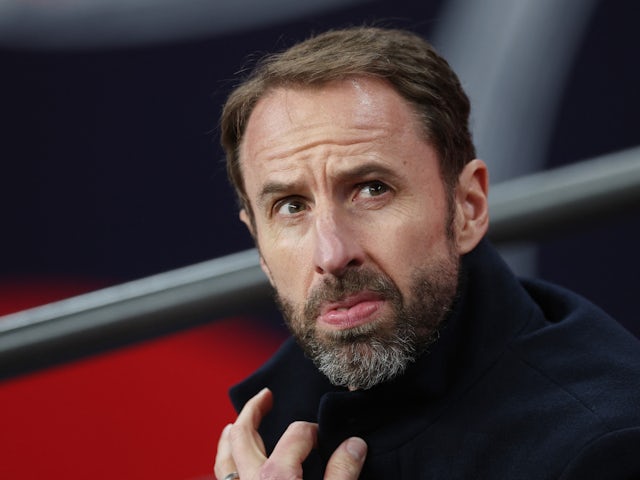UEFA Euro 2024 is fast approaching and with expectations sky-high, the pressure is on England manager Gareth Southgate to deliver a first piece of silver since 1966 for the Three Lions.
The choices in terms of both tactics and personnel on offer for Southgate this summer have been generating plenty of debate and supporters are eager to see what tactical strategy the 53-year-old has up his sleeve (or in his waistcoat pocket!).
While England's midfield and forward lines are heavily sprinkled with stardust and individual quality, Southgate has preferred pragmatism in recent international tournaments, with solid defensive organisation and a threat from set-pieces powering the nation's surge for honours.
Indeed, Southgate's risk-averse approach has dragged England to the very cusp of international glory four years ago and the beaten finalists at Euro 2020 will be eager to go one better in Germany this time around.
Below, we've taken a detailed look at possible tactics, formations and the personnel that Southgate could deploy at Euro 2024.
England's tactical flexibility key

When Gareth Southgate led England to a fourth-placed finish at the 2018 World Cup in Russia, he utilised a defensively robust 3-5-2 formation to great effect, though the framework of his system has evolved considerably since.
Six years ago, England's performances were characterised by blanket defending, direct passing, surges from the back by Harry Maguire and a defence-orientated midfield pairing of Kalvin Phillips and Declan Rice.
That system allowed England to secure their best finish at a World Cup since 1990. However, Southgate's philosophy still invited criticism, with perceived lack of expansiveness seeing the Three Lions run out of ideas against a Croatia side that fought back from an early deficit.
By the time Euro 2020 came around three years later, Southgate's way of working had evolved. England switched between 4-3-3, 4-2-3-1 and 3-4-3 formations, while ploughing a route to the competition's final as a more possession-based outfit. It was only a lost penalty shootout that stopped this approach from gaining the ultimate vindication – England ultimately lost, but they were not beaten.
England mixed things up again during their ultimately disappointing World Cup campaign in Qatar in December 2022, bouncing between 4-2-3-1 and 4-3-3 set-ups before their elimination in the quarter finals at the hands of France.
Southgate's willingness to adapt formations based on the opposition England faced at both Euro 2020 and World Cup 2022 was notable and a similar strategy should be expected at this summer's tournament in Germany.
4-2-3-1 and 4-3-3 offer fluidity
 © Reuters
© Reuters
In defence, England's number one goalkeeper Jordan Pickford is likely to have a back four of Kyle Walker, John Stones, Joe Gomez and Luke Shaw to marshal.
Elsewhere, Declan Rice remains England's chief protagonist in terms of his ball retention and possession-winning remits at the 'six' position, and Harry Kane retains his role as the team's attacking spearhead.
Spots in the rest of the XI are fair game, but while personnel might differ, the battle plan wrapped around 4-2-3-1 and 4-3-3 variations should largely remain the same.
Full-backs provide flexibility

In both systems, the two full-backs will be required to advance up the pitch to provide extra width, with England's widest attackers expected to play as inside forwards.
England's options on the flank – including Bukayo Saka, Phil Foden, Cole Palmer and Anthony Gordon – do much of their best work cutting infield, and Southgate will want to play to their strengths.
Liverpool man Trent Alexander-Arnold's creativity could open up an alternative avenue for Southgate to explore too, given his prior experience as an inverted full-back. He's less of a defensive all-rounder than Walker, but his passing range from deep could be a secret weapon.
Bellingham a differential factor
 © Reuters
© Reuters
In both the 4-2-3-1 and 4-3-3 formations, England will have two midfielders with licences of varying degrees to foray forward, with Rice kept in reserve as a safety net behind. Yet, the emergence of Jude Bellingham as a tour-de-force may have pushed Southgate towards four-at-the-back systems in a bid to accommodate the 20-year-old wonderkid.
Real Madrid star and recent Champions League winner Bellingham seems certain to play as an advanced midfielder for England this summer, while Man Utd's Kobbie Mainoo and Chelsea's Conor Gallagher can fit just about anywhere in the engine room.
With Bellingham still high off the momentum of a tremendous debut season at Real Madrid, switching between 4-2-3-1 and 4-3-3 depending on the in-game situation would give England the flexibility to adapt during different phases. Thus, the Three Lions could more smoothly shift focus from defence to attack in some fixtures.
3-4-3 a possible fallback formation for England?

Ever the pragmatist, Gareth Southgate will not hesitate to a more defensive setup at Euro 2024 if a more cautious approach is required in the competition's latter rounds.
At the last European Championships, Southgate switched to a three at the back formation for England's round of 16 bout with Germany, as well as the competition's final itself against Italy. In turn, the Three Lions head coach might settle on a similar shape if the going gets tough this summer.
The use of three centre backs in the 3-4-3 formation provides extra security, ensuring there are always multiple players to deal with any opposition threats – especially during transitions. This approach also allows the wing-backs to explore spaces further forward without leaving the backline too exposed.
Southgate has tinkered with three at the back formations during England friendlies over the past year, which suggests that set-up is still part of his tactical armoury, though it will only see the light of day if England lead the final 1-0 with mere minutes remaining.









